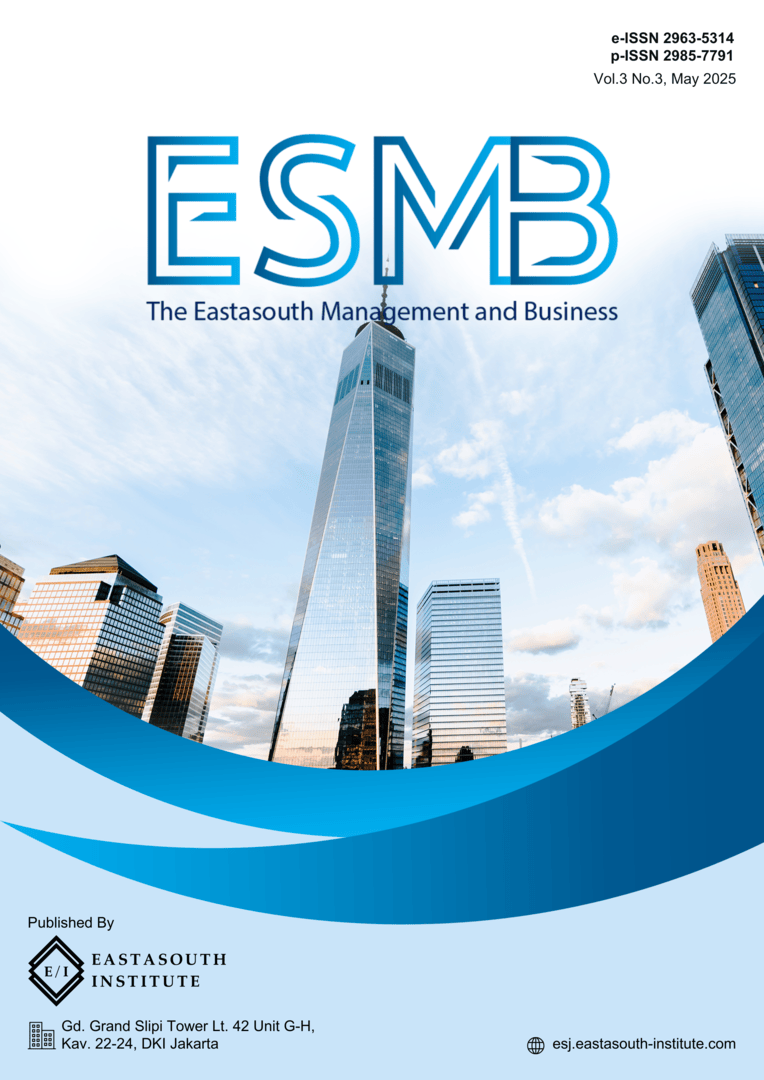Bibliometric Analysis of Work Envinronment and Employee Job Satisfaction
Main Article Content
Abstract
This study presents a comprehensive bibliometric analysis of the global research landscape on the relationship between work environment and employee job satisfaction. Using data retrieved from the Scopus database and analyzed with VOSviewer (version 1.6.x), the study maps publication trends, influential authors, collaborative networks, and thematic clusters spanning the years 2000–2024. The co-authorship analysis identifies prominent contributors such as Bakker A.B. and Judge T.A., while the country collaboration map reveals the dominance of the United States and the growing participation of countries like India, China, and Malaysia. Keyword co-occurrence analysis shows a conceptual structure centered on themes such as occupational health, job stress, leadership, and employee well-being, with “job satisfaction” and “work environment” as central nodes. Temporal and density visualizations suggest an increasing emphasis on holistic constructs such as work-life balance, mental health, and quality of life. The findings underscore the interdisciplinary and evolving nature of this field, offering guidance for future research directions and practical implications for organizational policy and human resource management.
Article Details

This work is licensed under a Creative Commons Attribution-ShareAlike 4.0 International License.
References
A. Raziq and R. Maulabakhsh, “Impact of working environment on job satisfaction,” Procedia Econ. Financ., vol. 23, pp. 717–725, 2015.
A. H. Ramli, “Work environment, job satisfaction and employee performance in health services,” Bus. Entrep. Rev., vol. 19, no. 1, pp. 29–42, 2019.
E. Tio, “The impact of working environment towards employee job satisfaction: a case study In PT. X,” iBuss Manag., vol. 2, no. 1, 2014.
G. K. Agbozo, I. S. Owusu, M. A. Hoedoafia, and Y. B. Atakorah, “The effect of work environment on job satisfaction: Evidence from the banking sector in Ghana,” J. Hum. Resour. Manag., vol. 5, no. 1, pp. 12–18, 2017.
Y. Badrianto and M. Ekhsan, “Effect of work environment and job satisfaction on employee performance in pt. Nesinak industries,” J. Business, Manag. Account., vol. 2, no. 1, 2020.
I. Idris, K. R. Adi, B. E. Soetjipto, and A. S. Supriyanto, “The mediating role of job satisfaction on compensation, work environment, and employee performance: Evidence from Indonesia,” Entrep. Sustain. Issues, vol. 8, no. 2, p. 735, 2020.
N. Atmaja and N. M. D. Puspitawati, “Effect of physical work environment through productivity employees job satisfaction as an intervening variable,” Int. J. Business, Econ. Law, vol. 17, no. 5, pp. 98–104, 2018.
N. Van Eck and L. Waltman, “Software survey: VOSviewer, a computer program for bibliometric mapping,” Scientometrics, vol. 84, no. 2, pp. 523–538, 2010.
A. B. Bakker and E. Demerouti, “Job demands–resources theory: Taking stock and looking forward.,” J. Occup. Health Psychol., vol. 22, no. 3, p. 273, 2017.
T. S. Kristensen, M. Borritz, E. Villadsen, and K. B. Christensen, “The Copenhagen Burnout Inventory: A new tool for the assessment of burnout,” Work Stress, vol. 19, no. 3, pp. 192–207, 2005.
E. L. Deci, A. H. Olafsen, and R. M. Ryan, “Self-determination theory in work organizations: The state of a science,” Annu. Rev. Organ. Psychol. Organ. Behav., vol. 4, no. 1, pp. 19–43, 2017.
M. Sverke, J. Hellgren, and K. Näswall, “No security: a meta-analysis and review of job insecurity and its consequences.,” J. Occup. Health Psychol., vol. 7, no. 3, p. 242, 2002.
T. D. Allen, “Family-supportive work environments: The role of organizational perceptions,” J. Vocat. Behav., vol. 58, no. 3, pp. 414–435, 2001.
L. W. Porter and R. M. Steers, “Organizational, work, and personal factors in employee turnover and absenteeism.,” Psychol. Bull., vol. 80, no. 2, p. 151, 1973.
T. Theorell et al., “A systematic review including meta-analysis of work environment and depressive symptoms,” BMC Public Health, vol. 15, pp. 1–14, 2015.
S. J. Bigos et al., “A prospective study of work perceptions and psychosocial factors affecting the report of back injury,” Spine (Phila. Pa. 1976)., vol. 16, no. 1, pp. 1–6, 1991.
G. E. Kreiner, “Consequences of work‐home segmentation or integration: A person‐environment fit perspective,” J. Organ. Behav. Int. J. Ind. Occup. Organ. Psychol. Behav., vol. 27, no. 4, pp. 485–507, 2006.
J. De Jonge, H. Bosma, R. Peter, and J. Siegrist, “Job strain, effort-reward imbalance and employee well-being: a large-scale cross-sectional study,” Soc. Sci. Med., vol. 50, no. 9, pp. 1317–1327, 2000.

